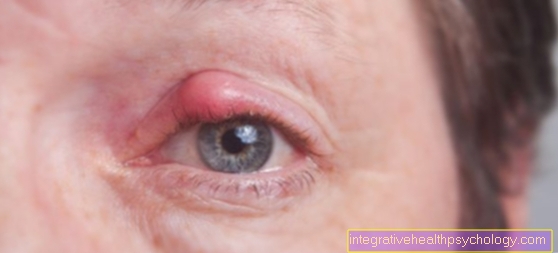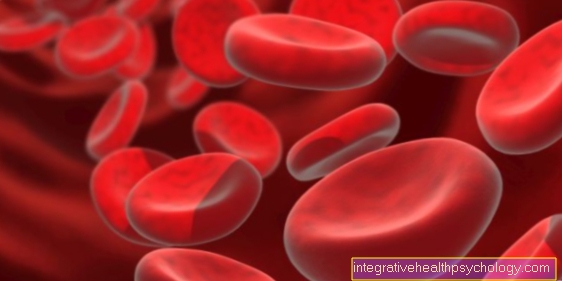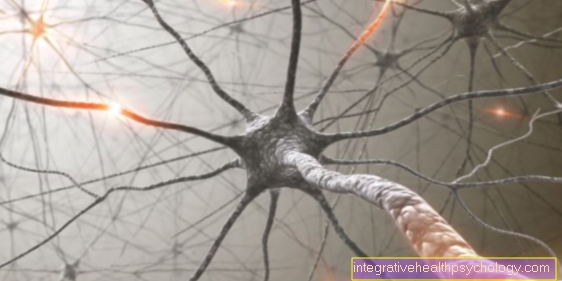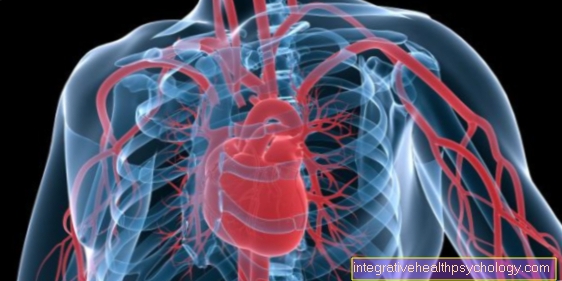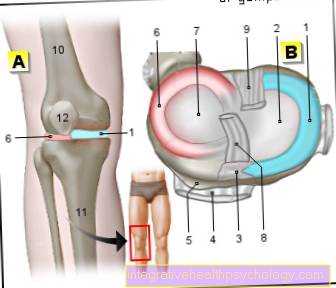endocrinology
Explanation and definition
The term endocrinology comes from the Greek and means something like "The study of the morphology and function of glands with internal secretion and hormones". The word endocrine describes hormonal glands in the human body that release their products (hormones) directly into the blood. They therefore have no duct for secretion and are thus clearly distinguished from the so-called exocrine glands, e.g. To distinguish between salivary and sebum glands, which release their products "to the outside world".
Hormones themselves are essential in human development. They serve as messenger substances and thus control all important body developments and functions. They develop their effect even at low doses, the effects of which are very closely controlled. Every hormone has its own receptor via a kind of "lock and key principle" so that errors are avoided as far as possible.
Nevertheless, diseases or illnesses can arise in our hormone system, which can be attributed to deficiencies, excesses or other interlocking imbalances in the hormone-producing glands. These are not always rare or very specific hormonal diseases that affect an organ such as related to the thyroid. Rather, the subject of endocrinology deals with a kind of network in which the various levers influence each other. So-called "common diseases" such as diabetes, osteoporosis or hormonal changes in old age also fall into this field.
Affected patients often have a long path of suffering behind them, because what seems halfway easy at first glance turns out to be extremely difficult in reality. The symptoms of a hormonal disease that occur are very individual and often at first glance not directly related to a clinical picture. The endocrinologist must view the human being as a holistic complex, coherent system and cannot limit himself to a single organ.

The most common diseases in endocrinology
But first we would like to give you an overview of the most common endocrinological diseases in the form of a list.
- Hypothyroidism
- Hyperthyroidism
- Graves disease
- Hashimoto's thyroiditis
- Addison's disease
- Cushing Syndrome
- Diabetes mellitus
Thyroid disorders
Hypothyroidism
If you have an underactive thyroid (Hypothyroidism) no or only insufficient amounts of the two thyroid hormones thyroxine (T4) and triiodothyronine (T3) are formed, so that their effect at the target site is reduced or completely absent. In general, the thyroid hormones have an activating effect on the metabolism, regulate the circulatory function, growth processes and influence the psyche. As a result, hypofunction has a negative effect on the metabolism.
An underactive thyroid is, apart from a few exceptional cases, incurable. However, long-term drug treatment can lead to a completely normal life.
For more detailed information, see our main page Hypothyroidism
Hyperthyroidism
If you have an overactive thyroid (Hyperthyroidism) the two thyroid hormones thyroxine (T4) and triiodothyronine (T3) are increased. This results in an increased hormonal effect at the target location, which is reflected in an overall increase in metabolism and a promotion of growth. In addition, T3 and T4 also influence the calcium and phosphate balance as well as the muscles. As a rule, the causes are to be found in the thyroid gland itself. Nevertheless, these can be further differentiated, which in turn affects the respective therapy.
You can find out more about this topic on our page for Hyperthyroidism
Graves disease
Graves' disease is an autoimmune disease, which means that the body's immune system is directed against its own cells. In this case it is the production of antibodies of the IgG type against the TSH receptors of the thyroid gland. These autoantibodies have the same effect as natural TSH, but lead to permanent stimulation of the receptors. This results in a permanent growth stimulus, which leads to the development of a goiter, as well as an increased production and secretion of the thyroid hormones T3 and T4.
In addition to the symptoms of an overactive thyroid (Hyperthyroidism) shows a characteristic triad of symptoms (Merseburg triad) consisting of goiter, tachycardia (rapid heartbeat) and exophthalmos. The latter lets the eyes "emerge" and, according to more recent findings, is due to an additional disease mechanism.
Read more about this under
- Graves disease
- Goiter - what does it mean?
Hashimoto's thyroiditis (autoimmune thyroiditis)
Hashimoto's thyroiditis is an autoimmune disease in which the immune system recognizes the body's own cells and tissues as foreign and destroys them. This leads to chronic inflammation of the thyroid gland and is one of the most common forms of hypothyroidism. The exact causes are not yet understood, but it is known that women are affected significantly more often than men.
The symptoms seem confusing at first, as the body tries to counter-regulate in the early stages, which is more likely to cause symptoms of an overactive thyroid. In the long run, however, these turn into the typical symptoms of an underactive thyroid. Diagnosis of Hashimoto's thyroiditis is made even more difficult by the complicated course of the disease and its individual characteristics.
Learn more about this topic on our main page Hashimoto's thyroiditis
Thyroid nodules (hot or cold nodules)
Roughly one can say that thyroid nodules are focal (single) changes in normal thyroid tissue. The exact causes are still not understood. A possible starting point is mutations in certain genes. In addition, it is already known that the development of nodules is significantly increased in iodine deficiency areas.
The differentiation between a cold and a hot lump can roughly be understood as meaning that if there is "less happens" - the affected area produces fewer thyroid hormones. A hot lump, on the other hand, produces more hormones - so this area is more active. Depending on the form, it does not necessarily mean that the person concerned suffers from an underactive or overactive thyroid, but the respective clinical picture can develop or even be socialized.
For more information on this topic, please also read our pages
- Hot lump in the thyroid gland
- Cold lump in the thyroid gland
Thyroid cancer
Thyroid carcinoma is a malignant change in the epithelial cells of the thyroid gland. Usually the first symptoms are disturbing lumps in the thyroid gland or an increase in size with the development of a goiter.
You can find more information on our main page Thyroid cancer
Parathyroid disorders
Overactive parathyroid glands
In the technical language as Hyperparathyroidism called, it is a disease in which the parathyroid glands produce and release too much parathyroid hormone. This is a hormone that is involved in the regulation of the calcium balance and increases the availability of calcium in the blood.
For more information on the topic, read our main page Overactive parathyroid glands.
Parathyroid hypofunction
The so-called Hypoparathyroidism it is an underactive parathyroid gland, i.e. insufficient production and secretion of parathyroid hormone. This can lead to a lack of calcium ions in the body, which among other things cause negative neurological symptoms.
The most common cause is surgical removal as part of a thyroid resection, but other reasons such as an autoimmune disease or chronic magnesium deficiency can also be considered.
If you are interested in this topic, read our main page Parathyroid hypofunction
Adrenal disorders
Addison's disease
Addison's disease is a so-called primary adrenal insufficiency. The rare but potentially fatal disease can occur in an acute or chronic form, in which the cells of the adrenal gland are destroyed. On the one hand, this leads to a reduced production of the mineral coricoid aldosterone, which has an impact on the fluid and mineral balance. On the other hand, there is an increased production of ACTH due to the disturbed control loop, which among other things is reflected in overpigmentation of the skin.
If you want to read more detailed information on this topic, go to our main page Addison's disease
Pheochromocytoma
A pheochromocytoma is a tumor, usually located in the adrenal medulla, which hormonally actively produces nor- and adrenaline, and rarely dopamine. The symptoms result from the resulting increased concentration of these hormones.
Read more on this topic on the main page Pheochromocytoma
Conn adenoma (primary hyperaldosteronism)
Read more on the topic: Conn syndrome
Cushing's disease
Cushing's disease is a disease of the pituitary gland (Pituitary gland) that produces too much of the hormone ACTH. Chushing's disease must be differentiated from the so-called Cushing syndrome, which was named after the same doctor. With Cushing's syndrome, however, there is a permanently increased concentration of cortisol in the body.
It is therefore primarily based on an excessive production of "Liberines" in the higher-level control system, which among other things also has a secondary effect on an increased concentration of cortisol. In Cushing's disease, for example, to overpigmentation of the skin due to a metabolic product of increased ACTH. Clinically, the symptoms appear similar, even if there are two different clinical pictures.
Cushing Syndrome
Further clinical pictures
Diabetes mellitus
Slang diabetes is a chronic metabolic disease. A distinction is made between two types, a relative and an absolute insulin deficiency. The fundamental problem here is a permanent increase in blood sugar (Hyperglycemia). The cause is an insufficient effect of the important hormone insulin.
In type 1 diabetes mellitus there is an absolute insulin deficiency. The hormone-producing cells of the pancreas are destroyed by an autoimmune reaction and are therefore unable to function. The disease usually manifests itself at an early age and must inevitably be treated with an external administration of insulin.
In contrast, type 2 diabetes mellitus is a relative insulin deficiency, as either too little insulin is produced in the pancreas or the effect on the target organs is reduced. In the latter case, one speaks of what is known as insulin resistance. The main part of this type goes back to the metabolic syndrome ("affluence disease"). This partly explains the well-known name "old-age diabetes", which can no longer count today, because the factors obesity (especially body fat on the stomach), increased blood fat levels, high blood pressure and glucose tolerance disorders (probably due to excessive consumption) are also becoming increasingly younger affect. So the term "relative" means there is insulin, but not enough to meet your needs. As a rule, these patients are also dependent on an external dose, but can change their life through changes in life, e.g. a healthy diet and exercise intervene positively in this control cycle.
Read more about this on our pages
- Type 1 diabetes mellitus
- Type 2 diabetes mellitus
Diabetes insipidus
In this relatively rare hormone deficiency disease there is a so-called Polyuria (extremely high urine excretion) with up to 25 liters per day and thus resulting in a Polydypsia (increased thirst). It is based on a dysregulation or reduced release of ADH (antidiuretic hormone) from the hypothalamus. Normally the hormone is secreted during the so-called osmoregualtion, thus in the kidney by the incorporation of Aquaporins ("Water channels") more water can be reabsorbed or is not lost to the body. The reduction in ADH explains the sometimes enormous amounts of urine excreted.
Depending on the area in which the disorder is located, in the brain or in the kidney "on site", a distinction is also made between diabetes inspidus centralis and renalis.
Read more about this on our main page Diabetes insipidus
Schwartz-Bartter Syndrome
This clinical picture is also a disturbance of the balance in the osmoregulation. However, in Schwartz-Bartter syndrome there is an increased secretion of ADH (Antidiuretic hormone, vasopressin). This results in a significantly reduced fluid excretion via the kidneys and urine. That draws i.a. a so-called hypotonic hyperhydration with dilute natremia after yourself. This means that too much water is available to the body and bloodstream, the blood is "diluted" and thus the concentration of important electrolytes such as e.g. Sodium reduced.
The most common cause is a paraneoplastic effect of a small bronchial carcinoma ("accompanying symptoms of cancer"), but numerous other causes such as trauma, hypothyroidism or medication are also possible.
Read more about this on our main page Schwartz-Bartter Syndrome
Acromegaly
This clinical picture bears this name because the acra (hands, fingers, feet, ears, nose ...) develop visibly larger and continue to grow. The internal organs are also affected. It is based on an adenoma (benign) tumor Pituitary gland (Pituitary gland), which ensures that it secretes more growth hormone (somatotropin, STH or GH).
Learn more about this on the main page too Acromegaly








